Tupolev Tu-134
The Tupolev Tu-134 (NATO reporting name: Crusty) is a twin-engined, narrow-body, jet airliner built in the Soviet Union from 1966 to 1989. It is the world's most-produced twinjet of its class. The original version featured a glazed-nose design and, like certain other Russian airliners (including its sister model the Tu-154), it can operate from unpaved airfields.
| Tu-134 | |
|---|---|
_RA-65906_(3280346895).jpg) | |
| A Yamal Airlines Tu-134A-3 tail number RA-65906 | |
| Role | Airliner |
| National origin | Soviet Union |
| Manufacturer | Tupolev |
| First flight | July 29, 1963 |
| Introduction | September 9, 1970[1] |
| Status | In limited use |
| Primary users | Aeroflot (historical) Soviet Air Force (historical) Air Koryo ALROSA |
| Produced | 1966–1989[2] |
| Number built | 854 (852 + 2 prototypes)[2] |
| Developed from | Tupolev Tu-124 |
One of the most widely used aircraft in former Comecon countries, the number in active service is decreasing because of operational safety concerns and noise restrictions. The model has seen long-term service with some 42 countries, with some European airlines having scheduled as many as 12 daily takeoffs and landings per plane. In addition to regular passenger service, it has also been used in various air force, army and navy support roles; for pilot and navigator training; and for aviation research and test projects. In recent years, a number of Tu-134s have been converted for use as VIP transports and business jets. A total of 854 Tu-134s were built of all versions (including test bed examples) with Aeroflot as the largest user; by 1995, the Tu-134 had carried 360 million passengers for that airline.
Design and development
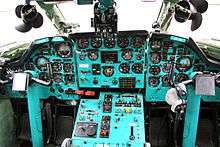
Following the introduction of engines mounted on pylons on the rear fuselage by the French Sud Aviation Caravelle, airliner manufacturers around the world rushed to adopt the new layout. Its advantages included clean wing airflow without disruption by nacelles or pylons and decreased cabin noise. At the same time, placing heavy engines that far back created challenges with the location of the centre of gravity in relation to the centre of lift, which was at the wings. To make room for the engines, the tailplanes had to be relocated to the tail fin, which had to be stronger and therefore heavier, further compounding the tail-heavy arrangement.
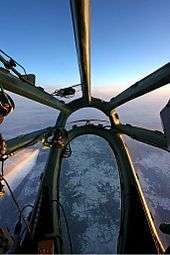
During a 1960 visit to France, Soviet leader Nikita Khrushchev was so impressed by the quiet cabin of the Caravelle, that on 1 August 1960 the Tupolev OKB received an official directive to create the Tu-124A with a similar engine arrangement. The requirement was also driven by the need to replace slow, aging piston-engined Il-14s on domestic routes. In 1961, the Soviet state airline, Aeroflot, updated its requirement specifications to include greater payload and passenger capacity.
The first Tu-124A prototype, SSSR-45075, first flew on 29 July 1963. On 22 October 1963, the prototype British BAC One-Eleven, which had a similar layout, crashed with the loss of all crew while testing its stalling properties. The aircraft had entered pitch-up: the high-mounted tailplane became trapped in the turbulent wake produced by the wings (deep stall), which prevented recovery from the stall. As a result, the tailplane on Tu-124A was enlarged by 30% for greater control authority. Since Aeroflot's requirements dictated a larger aircraft than initially planned, the Soloviev Design Bureau developed the more powerful D-30 low-bypass turbofan engines. On 20 November 1963, the new airliner was designated Tu-134.
Design curiosities of the Tu-134 included a sharp wing sweepback of 35 degrees, compared to 25–28 degrees in its counterparts. The engines on early production Tu-134s lacked thrust reversers, which made the aircraft one of the few airliners to use a brake parachute for landing. The majority of onboard electronics operated on direct current. The lineage of early Soviet airliners could be traced directly to the Tupolev Tu-16 strategic bomber, and the Tu-134 carried over the glass nose for the navigator and the landing gear fitted with low-pressure tires to permit operation from unpaved airfields.
Serial production began in 1966 at the Kharkov Aviation Production Association, and production of the Tu-124 was discontinued. The Tu-134 was designed for short-haul lines with low passenger traffic. Originally the aircraft had 56 seats in a single class configuration, or 50 seats in a two-class configuration.
In 1968, Tupolev began work on an improved Tu-134 variant with a 72-seat capacity. The fuselage received a 2.1-meter (6 ft 11 in) plug for greater passenger capacity and an auxiliary power unit in the tail. As a result, the maximum range was reduced from 3,100 kilometers to 2,770 kilometers. The upgraded D-30 engines now featured thrust reversers, replacing the parachute. The first Tu-134A, converted from a production Tu-134, flew on 22 April 1969. The first airline flight was on 9 November 1970. An upgraded version, the Tu-134B began production in 1980, with the navigator position abandoned, and seating capacity increased to 96 seats. Efforts subsequently began to develop a Tu-134D with increased engine thrust, but the project was cancelled.
Operational history
In September 1967, the Tu-134 made its first scheduled flight from Moscow to Adler. The Tu-134 was the first Soviet airliner to receive international certification from the International Civil Aviation Organization, which permitted it to be used on international routes. Due to this certification, Aeroflot used most of its Tu-134s on international routes. In 1968, the first export customers, Interflug of East Germany, LOT Polish Airlines and Malév Hungarian Airlines purchased the Tu-134. In 1969, the Tu-134 was displayed at the Paris Air Show.
From 1972, Aeroflot began placing the Tu-134 in domestic service to Baku, Yerevan, Kiev, Kishinev, Krasnodar, Leningrad, Omsk, Riga, and Sochi from Sheremetyevo International Airport in Moscow.
In its early years, the Tu-134 developed a reputation for reliability and efficiency, especially when compared with previous Soviet designs. After the establishment of tougher noise standards in the ICAO regulations in 2002, the Tu-134 was banned from most western European airports for its high noise levels. In early 2006, 245 Tu-134s were still in operation, 162 of which were in Russia. After a fatal accident in March 2007, and at the instigation of Russian Minister of Transportation Igor Levitin, Aeroflot announced that it would be retiring its fleet, and the last Tu-134 was removed from service on 1 January 2008. Some were still in operations with Aeroflot subsidiaries on local routes within Russia. The Tu-134 also found a new life as a business jet with many having an expensive business interior installed. High fuel and maintenance costs are increasingly limiting the number used today.
In June 2011, as a response to RusAir Flight 9605 which resulted in 47 fatalities, Russian president Dmitry Medvedev ordered preparations for taking the Tu-134 out of use by 2012.
On 22 May 2019, the final passenger flight of the Tu-134 in Russia took place.[3]
Many Tu-134s have been preserved as memorials at airports throughout the former Soviet Union. A former Malév Tu-134 (registration HA-LBA) is on display at the Aeropark at Budapest Ferenc Liszt International Airport[4] in Hungary.
Variants
- Tu-134
- The glass-nosed version. The first series could seat up to 64 passengers, and this was later increased to 72 passengers. The original designation was Tu-124A.
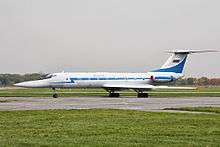
- Tu-134A
- Second series, with upgraded engines, improved avionics, seating up to 84 passengers. All Tu-134A variants have been built with the distinctive glass nose and chin radar dome, but some were modified to the B standard with the radar moved to the nose radome.
- Tu-134A-2
- The glass nose was replaced.
- Tu-134A-3
- Second series, powered by two updated Soloviev D-30 turbofan engines.
- Tu-134A-5
- Most recent version.
- Tu-134B
- Second series, 80 seats, radar moved to the nose radome, eliminating the glazed nose. Some Tu-134B models have long-range fuel tanks fitted under the fuselage; these are visible as a sizable bulge.
- Tu-134BV
- Space shuttle work model.
- Tu-134LK
- Cosmonaut training version.
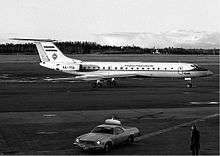
- Tu-134UBL
- Tu-160 crew training version, with Tu-160 nose cone.
- Tu-134UBK
- Naval version of Tu-134UBL. Only one was ever built.
- Tu-134BSh
- Tu-22M crew trainer, fitted with a Tu-22M radar in the nose.
- Tu-134Sh-1
- Crew trainer with bomb racks for heavy bomber crews
- Tu-134Sh-2
- navigator trainer for tactical bomber crews
- Tu-134SKh
- Crop survey version.
Operators
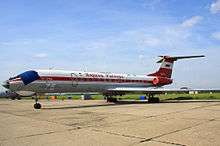
Civil operators
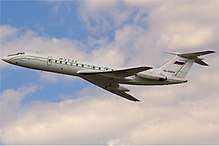
As of 2019, just two Tupolev Tu-134s remain in airline service. Operators are:[5]
- Air Koryo (2)
- Syrianair (also used for VIP purposes)
Former civil operators
.jpg)
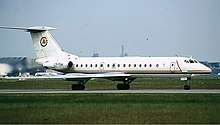
- Albanian Airlines[6]
- Albtransport Airlines

- CSA Czech Airlines
- Kyrgyzstan Air Company – 1 crashed on December 28, 2011
- Kyrgyzstan Airlines
- Air Lithuania
- Lithuanian Airlines
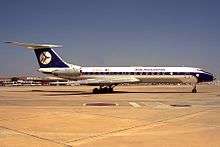
- Imperial Air[7]
- Aero Rent
- Aeroflot-Plus
- Alrosa-Avia
- Center-South
- Izhavia
- Rossiya Airlines (government fleet)
- Samara Airlines
- Kosmos Airlines (3)
- Meridian Airlines (1)[8]
- Sirius-Aero
- Turukhan Airlines
- UTair Express
Military operators
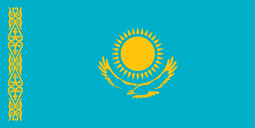
- Armed Forces of the Republic of Kazakhstan – 2 use to passenger transport

- Russian Air Force – 1449th Air Base located at Tambov
- Russian Naval Aviation
- Russian Coast Guard
- Russian Presidential Transport Flight

- Syrian Air Force

- Ukrainian Air Force - 15th Transport Aviation Brigade "Aircraft Designer Oleg Antonov" located at Boryspil International Airport, Kiev Oblast
Former military operators
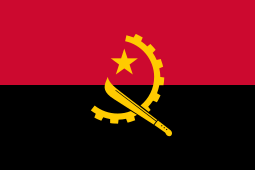
- People's Air and Air Defence Force of Angola

- Armenian Air Force – 1 stored

- Azerbaijan Air Force

- Belarus Air Force
.svg.png)
- Bulgarian Air Force

- Czech Air Force

- Czechoslovak Air Force – Passed on successor states

- German Air Force – former operator, taken over from East German Air Force after German reunification

- Georgian Air Force
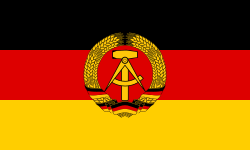
- East German Air Force
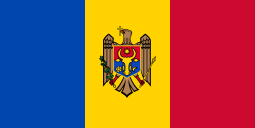
- Moldovan Air Force
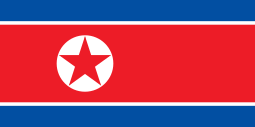
- North Korean Air Force

- Polish Air Force. Operated 2 from 1972 to 1977 (later LOT) and 2 from 1977 to 1992. Retired, replaced by 2 Tupolev Tu-154M.

- Soviet Air Force
- Soviet Naval Aviation. Passed on successor states.
- Soviet Space Agency
- Soviet Internal Troops – Prisoner Transport Service
- Syrianair (1)
Accidents and incidents
Some 69 Tu-134 have been destroyed in accidents and wars, of which 35 were non-fatal incidents (in one of the remaining 34 fatal incidents no one on the plane died).
| Date | Tail number | Crash site | Casualties | Description | Refs |
|---|---|---|---|---|---|
| 14 January 1966 | СССР-45076 | 8/8 | Crash of second prototype in flight testing. | [10] | |
| 23 May 1971 | YU-AHZ | 78/83 | Aviogenex Flight 130 crashed on approach to Rijeka Airport located on the island of Krk, rough landing in bad weather conditions. | [11][12] | |
| 16 September 1971 | HA-LBD | 49/49 | Malév Flight 110 crashed near Boryspil International Airport, Kiev in bad weather, following two missed approaches, after a generator failure caused the crew to switch to batteries. | [13] | |
| 30 June 1973 | СССР-65668 | 7+2/85 | Aeroflot Flight 512 aborted takeoff, overran the runway, and crashed into a building. | [14] | |
| 1 September 1975 | DM-SCD | 27/34 | Pilot failed to check rate of descent, crashed on landing. Later sentenced to 5 years in prison for negligence. Other crew members sentenced to three years. | [15] | |
| 21 September 1977 | HA-LBC | 29/53 | Malev Flight 203 from Istanbul to Budapest with an intermediate stop at Bucharest struck level ground on approach, probably as a result of flying at reduced power, unnoticed by the crew. | [16] | |
| 16 March 1978 | LZ-TUB | 73/73 | Crashed on climb out from Sofia Airport near the village of Gabare following an abnormal descent. | [17] | |
| 22 March 1979 | CCCP-65301 | 4/5 | Crashed on landing in poor weather due to overloading. | [18] | |
| 11 August 1979 | СССР-65816 | 178/178 | Two Aeroflot Tu-134s collided near Dneprodzerzhinsk due to ATC errors. | [19][20] | |
| СССР-65735 | |||||
| 17 June 1982 | CCCP-65687 | 15/16 | A test aircraft operated by the Soviet government crashed during landing. The pilot had ignored warnings that he was descending too fast and collided with a radio tower. | [21] | |
| 30 August 1983 | CCCP-65129 | 90/90 | Aeroflot Flight 5463 struck a mountain after the crew began descending too soon. | [22] | |
| 18 November 1983 | CCCP-65807 | 8 | Hijacked by nine people. After returning to Tbilisi, commandos stormed the aircraft, killing three hijackers. The aircraft was written off following airframe deformation caused by excessive G-forces. | [23] | |
| 10 January 1984 | LZ-TUR | 50/50 | Crashed short of the runway while attempting an overshoot after coming in too low. | [24] | |
| 1 February 1985 | CCCP-65910 | 58/80 | Aeroflot Flight 7841 force-landed after the crew failed to de-ice the wings before takeoff. The ice caused both engines to flame out. | [25] | |
| 3 May 1985 | CCCP-65856 | 94/94 | Mid-air collision with military An-26 due to ATC errors. | [26][27] | |
| 101 red | |||||
| 2 July 1986 | CCCP-65120 | 54/94 | Aeroflot Flight 2306 force-landed following a possible fire in the cargo hold. | [28] | |
| 19 October 1986 | C9-CAA | 34/44 | The Mozambican Presidential jet struck the ground during a thunderstorm after the pilot ignored the ground proximity warning system. The crash remains the worst in South Africa. | [29] | |
| 20 October 1986 | CCCP-65766 | 70/94 | Aeroflot Flight 6502 struck the ground at high speed and crashed upside down. Pilot sentenced to six years in prison. | [30] | |
| 12 December 1986 | CCCP-65795 | 72/82 | After being cleared to land on runway 25L at Berlin Schönefeld Airport, Aeroflot Flight 892 from Minsk proceeded to approach runway 25R which was closed for construction. While attempting to switch to the correct runway, the aircraft struck trees and crashed. | [31] | |
| 27 February 1988 | CCCP-65675 | 20/51 | Aeroflot Flight 7867 crashed beside the runway due to a crew error while transitioning from ILS approach to visual landing. | [32] | |
| 9 September 1988 | VN-A102 | 76/90 | Vietnam Airlines Flight 831 crashed after entering a storm and descended below minimum altitude. The aircraft struck the ground and broke up. The aircraft was possibly struck by lightning. | [33] | |
| 13 January 1990 | CCCP-65951 | 27/71 | Aeroflot Flight 6246 force landed following a fire in the cargo hold, possibly caused by a short circuit. | [34] | |
| 27 August 1992 | CCCP-65058 | 84/84 | Aeroflot Flight 2808 struck trees and crashed short of the runway while attempting ILS approach. | [35] | |
| 20 September 1993 | 65809 | 28/28 | Transair Georgia airliner shootdowns: On 20 September, 65809 was destroyed on the ground at Babusheri Airport. On 21 September, 65893 was shot down by a missile and crashed in the sea, killing all aboard. On 23 September, CCCP-65501 was destroyed on the ground after it was struck by a rocket while passengers were boarding, killing a crew member. | [36][37][38] | |
| 65893 | |||||
| CCCP-65501 | |||||
| 9 September 1994 | RA-65976 | 8/8 | Mid-air collision with a Tu-22M research aircraft during a photographic chase flight. The collision damaged the stabilizer of the Tu-134 and it lost control and crashed. The Tu-22 was able to land safely. | [39] | |
| 32 red | |||||
| 24 June 1995 | RA-65617 | 16/80 | Landed late and overran runway in a storm. The aircraft was leased from Komi Avia. | [40] | |
| 5 December 1995 | 4K-65703 | 52/82 | Azerbaijan Airlines Flight 56 crashed on takeoff after both engines failed due to a maintenance error. | [41] | |
| 3 September 1997 | VN-A120 | 65/66 | Vietnam Airlines Flight 815 descended below its approach path on a non-precision approach. Despite warnings from the other crew members that the craft was too low, the captain continued the approach, resulting in the crash. | [42] | |
| 24 August 2004 | RA-65080 | 44/44 | Volga-Aviaexpress Flight 1303 disappeared from radar forty-one minutes after taking off from Moscow's Domodedovo Airport. Witnesses reported seeing an explosion in the sky, and wreckage was located shortly thereafter. Later investigation revealed that the aircraft had been destroyed by a suicide bomber, along with a Tu-154 on the same day. | [43] | |
| 10 July 2006 | 05 red | 0/20 | Operated on behalf of the Black Sea Fleet Aviation unit (VVS ChF) of the Russian Navy. It was carrying Adm. Vladimir Masorin who was on an inspection trip to the Black Sea Fleet. On takeoff the no. 1 engine failed and caught fire, possibly as a result of a bird strike. Takeoff was aborted, but the Tupolev overran the runway. Three navy officers were injured. | [44] | |
| 17 March 2007 | RA-65021 | 6/57 | UTair Flight 471 landed hard in poor weather due to pilot and ATC errors. The aircraft then bounced and inverted, but did not catch fire. Aeroflot retired its Tu-134 fleet in the wake of this accident. | [45] | |
| 20 June 2011 | RA-65691 | 47/52 | After technical problems trying to land in heavy fog, and unable to reach Petrozavodsk Airport, RusAir Flight 9605 tried to land on a road 2 km from the airport at 1955 UTC (2355 MSD). The plane flipped and caught fire as it struck the ground. There is speculation that the pilot may have mistaken the motorway for the runway. After the crash, the Russian government ordered that all Tu-134s be removed from commercial service by 2012. | [46] | |
| 28 December 2011 | EX-020 | 0/79 | Kyrgyzstan Air Company Flight 3 landed hard in marginal weather conditions, breaking off the right wing. The aircraft then rolled over. A fire started, but was quickly contained with no casualties. | [47][48] |
Source: Aircraft Accident Database[49]
Specifications (Tu-134A)
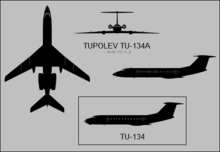
Data from OKB Tupolev[50], OAO Tupolev[51]
General characteristics
- Crew: 3–5 flight crew + 3–4 flight attendants
- Capacity: 72–84 passengers / 8,200 kg (18,078 lb)
- Length: 37.1 m (121 ft 9 in)
- Wingspan: 29.01 m (95 ft 2 in)
- Diameter: 2.9 m (9 ft 6 in) fuselage diameter
- Height: 9.02 m (29 ft 7 in)
- Wing area: 127.3 m2 (1,370 sq ft)
- Airfoil: root: PR-1-10S-9 (15.7%) ; tip: PR-1-10S-9 (12%)[52]
- Empty weight: 27,960 kg (61,641 lb)
- Gross weight: 47,000 kg (103,617 lb)
- Max takeoff weight: 47,600 kg (104,940 lb)
- Fuel capacity: 13,200 l (3,500 US gal; 2,900 imp gal)
- Powerplant: 2 × Soloviev D-30-II turbofan engines, 66.68 kN (14,990 lbf) thrust each
Performance
- Maximum speed: 950 km/h (590 mph, 510 kn)
- Cruise speed: 750–850 km/h (470–530 mph, 400–460 kn)
- Range: 1,900–3,000 km (1,200–1,900 mi, 1,000–1,600 nmi)
- Ferry range: 3,200 km (2,000 mi, 1,700 nmi)
- Service ceiling: 12,100 m (39,700 ft)
See also
Aircraft of comparable role, configuration and era
Related lists
References
- http://aeroflotarchives.com/tupolev-tu-134.html Cites first revenue flight, Obtained 15 April 2019
- Ту-134. russianplanes.net (in Russian). Archived from the original on 4 September 2015. Retrieved 2 November 2015.
- Ту-134 отправился в заключительный пассажирский рейс в России [Tu-134 went to the final passenger flight in Russia] (in Russian). 22 May 2019. Retrieved 26 May 2019.
- "Aeropark Budapest Repülőmúzeum". aeropark.hu. Archived from the original on 27 March 2019. Retrieved 21 April 2019.
- http://dl.magazinedl.com/magazinedl/Flight%20International/2019/Flight%20International%20-%2030%20July%202019%28magazinedl.com%29.pdf
- Kingsley-Jones 2002, p. 54
- "Aviation Safety Network – Imperial Air Peru". Archived from the original on 2012-11-03. Retrieved 2011-01-03.
- "Meridian Airline's website". meridian-avia.com (in Russian and English). Retrieved 2019-04-22.
- Aviogenex at rzjets.com, retrieved 13-12-2014
- Accident description for CCCP-45076 at the Aviation Safety Network. Retrieved on 2015-12-17.
- ASN Aircraft accident Tupolev 134A YU-AHZ Rijeka Airport (RJK) Archived 2011-03-19 at the Wayback Machine — 2 photographs
- Авиакатастрофы самолётов Ту-134 Archived 2008-03-17 at the Wayback Machine (in Russian)
- Accident description for HA-LBD at the Aviation Safety Network. Retrieved on 2015-12-17.
- Accident description for CCCP-65668 at the Aviation Safety Network. Retrieved on 2015-12-17.
- Accident description for DM-SCD at the Aviation Safety Network. Retrieved on 2015-12-17.
- Accident description for HA-LBC at the Aviation Safety Network. Retrieved on 2015-12-17.
- Accident description for LZ-TUB at the Aviation Safety Network. Retrieved on 2015-12-17.
- Accident description for CCCP-63501 at the Aviation Safety Network. Retrieved on 2015-12-17.
- Accident description for CCCP-65816 at the Aviation Safety Network. Retrieved on 2015-12-17.
- Accident description for CCCP-65735 at the Aviation Safety Network. Retrieved on 2015-12-17.
- Accident description for CCCP-65687 at the Aviation Safety Network. Retrieved on 2015-12-17.
- Accident description for CCCP-65129 at the Aviation Safety Network. Retrieved on 2015-12-17.
- Hijack description for CCCP-65807 at the Aviation Safety Network. Retrieved on 2015-12-17.
- Accident description for LZ-TUR at the Aviation Safety Network. Retrieved on 2015-12-17.
- Accident description for CCCP-65910 at the Aviation Safety Network. Retrieved on 2015-12-17.
- Accident description for CCCP-65856 at the Aviation Safety Network. Retrieved on 2015-12-17.
- Accident description for 101 red at the Aviation Safety Network. Retrieved on 2015-12-17.
- Accident description for CCCP-65120 at the Aviation Safety Network. Retrieved on 2015-12-17.
- Accident description for C9-CAA at the Aviation Safety Network. Retrieved on 2015-12-18.
- Accident description for CCCP-65766 at the Aviation Safety Network. Retrieved on 2015-12-18.
- "ASN Aircraft accident Tupolev 134A CCCP-65795 Berlin-Schönefeld". Archived from the original on 2013-06-01. Retrieved 2010-05-03.
- Accident description for CCCP-65675 at the Aviation Safety Network. Retrieved on 2015-12-18.
- Accident description for VN-A102 at the Aviation Safety Network. Retrieved on 2015-12-18.
- Accident description for CCCP-65951 at the Aviation Safety Network. Retrieved on 2015-12-18.
- Accident description for CCCP-65058 at the Aviation Safety Network. Retrieved on 2015-12-18.
- Criminal description for 65809 at the Aviation Safety Network. Retrieved on 2015-12-18.
- Criminal description for 65893 at the Aviation Safety Network. Retrieved on 2015-12-18.
- Criminal description for CCCP-65501 at the Aviation Safety Network. Retrieved on 2015-12-18.
- Accident description for RA-65716 at the Aviation Safety Network. Retrieved on 2015-12-18.
- Accident description for RA-65617 at the Aviation Safety Network. Retrieved on 2015-12-18.
- Accident description for 4K-65703 at the Aviation Safety Network. Retrieved on 2015-12-18.
- Accident description for VN-A120 at the Aviation Safety Network. Retrieved on 2015-12-18.
- Criminal description for RA-65080 at the Aviation Safety Network. Retrieved on 2015-12-18.
- Accident description for 05 red at the Aviation Safety Network. Retrieved on 2020-06-19.
- Accident description for RA-65021 at the Aviation Safety Network. Retrieved on 2015-12-18.
- (in Russian) http://www.itar-tass.com/en/c154/169237.html Archived 2011-06-21 at WebCite
- "Tu-134 passenger plane crashes in Kyrgyzstan". Vestnik Kavkaza. 2011-12-28. Archived from the original on 2012-05-22. Retrieved 2012-07-27.
- "Aviation Herald Report".
- "AirDisaster: Aircraft Accident Database". Archived from the original on 2011-06-07. Retrieved 2010-05-03.
- Gordon, Yefim; Rigmant, Vladimir; Boyd, Alexander (translator) (2005). OKB Tupolev : a history of the design bureau and its aircraft. Hinkley: Midland. pp. 248–246. ISBN 1857802144.
- "Tupolev Tu-134". Archived from the original on 2006-05-15. Retrieved 2006-05-10.
- Lednicer, David. "The Incomplete Guide to Airfoil Usage". m-selig.ae.illinois.edu. Retrieved 16 April 2019.
- Kingsley-Jones, Max (27 August – 2 September 2002). "World airliner census: Running to Stand Still". Flight International. Vol. 162 no. 4846. pp. 30–55. ISSN 0015-3710.CS1 maint: ref=harv (link)
External links
| Wikimedia Commons has media related to Tupolev Tu-134. |